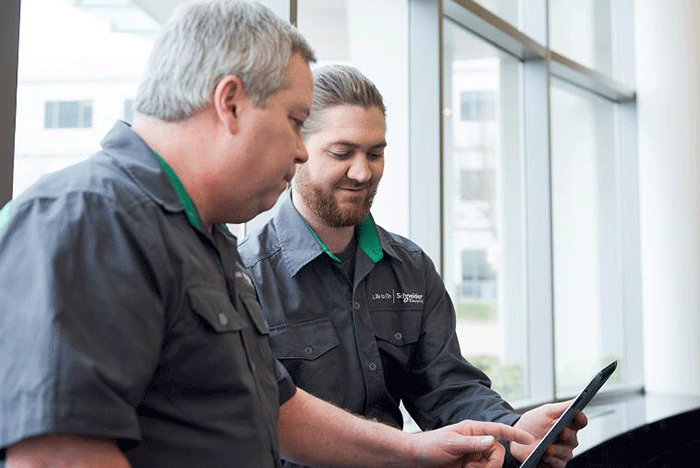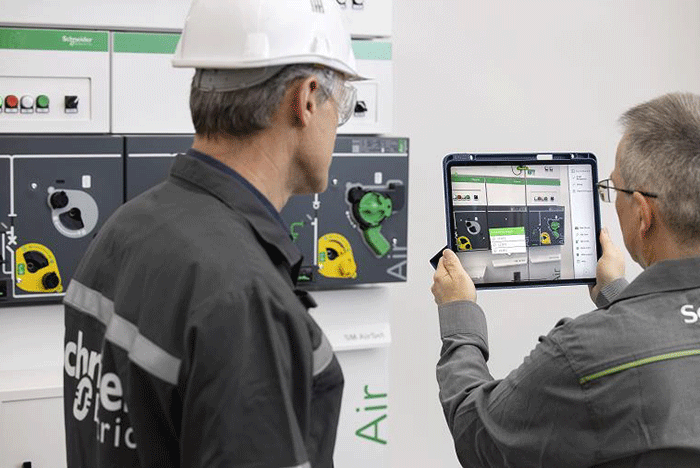IoT-enabled control of infrastructure

Schneider Electric Connected Services remotely monitors all connected physical infrastructure devices 24/7 with EcoStruxureTM Asset Advisor, enabling secure remote trouble shooting for quick resolution of critical incidents and peace of mind.
Photo courtesy of Schneider Electric
The coronavirus pandemic is fundamentally changing how everybody lives, works and plays. From socializing to education to work, every major realm of life is going digital, in some cases, indefinitely. In health care, digitization’s impact will extend far beyond telehealth and electronic medical records.
Health care infrastructure — power distribution, information technology (IT) infrastructure and building control systems — also is a key candidate for digital transformation. Before the pandemic, there was already a growing industry shift toward holistically managing these disparate systems under a single internet of things (IoT)-enabled umbrella.
Four benefits
Now, industry adoption of this centralized “system of systems” will likely accelerate, due to the following four core benefits:
Benefit 1. Proactive digital maintenance for better business continuity. Even during business-as-usual, unexpected maintenance issues can keep hospital managers stuck putting out fires instead of preventing them. When they are facing a surge in patients, the last thing they want is downtime, especially when it’s caused by routine issues.
The best way to avoid this situation is to gain the ability to anticipate the future. Software analytics, paired with engineers, crunch building management system (BMS) and power distribution system data to notify hospitals of issues like leaky valves or failing circuit breakers — before they cause downtime. With newfound visibility and control over a facility’s infrastructure, a hospital team can focus on high-value work and strengthen business continuity.
Proactive maintenance and remote monitoring go hand-in-hand. Hospital staff can monitor from home, paying virtual “doctor’s visits” to check on the health of infrastructure. It’s like telehealth, but for a facility’s infrastructure.
Benefit 2. Boost patient and staff satisfaction with digitally driven efficiency. Another key benefit of digitization is that it enhances patient and staff satisfaction. With digital BMSs, hospitals can give patients control over room temperature, lighting and nurse calls. They can adjust their settings from a tablet or phone without needing to rely on hospital staff. That frees up providers to focus on care while empowering their patients to feel more at home.
When it comes to staff satisfaction, IoT-connected systems reduce administrative work and streamline clinical workflows, giving hospital teams more time with patients. A simple example: Instead of roaming around a ward in search of a heart rate monitor, or some other medical equipment, staff can use a real-time location system (RTLS) to locate the nearest machine instantly.
Benefit 3. Find previously invisible operational inefficiencies. Many hospitals are now striving to reduce costs in the wake of the pandemic. Energy use is a sensible target. According to the Environmental Protection Agency's ENERGY STAR® program, for every $1 saved on energy costs, a non-profit hospital sees the equivalent of $20 of new revenue (i.e., saving energy has a major multiplier effect).
Digitization is a key enabler for operational efficiency. By monitoring a facility’s systems down to the device level and running that data through cloud analytics, hospital managers will spot previously invisible inefficiencies like IT hotspots, clogged filters or faulty valves. These software tools generate recommendations ranked by how much the hospital will save, so the hospital manager and team can decide where to spend their time.

Schneider Electric field service reps using EcoStruxureTM Augmented Operator Advisor, which dynamically combines contextual and local information on a mobile device, creating a fusion of the physical, real-life environment with virtual objects.
Photo courtesy of Schneider Electric
Here’s an example of how connected systems lower energy use and carbon emissions. When a hospital manager integrates a patient admission system with a BMS and real-time location system, hospital managers can reduce HVAC or lighting in empty rooms. This efficiency tweak can be automated across the entire building, multiplying the impact.
For energy-intensive and critical environments such as operating theaters, connecting to the surgery scheduling systems will allow hospital managers to optimize how they utilize their ventilation system, running this equipment only when it’s needed.
Benefit 4. Leverage unique funding opportunities to modernize. As the saying goes, “necessity is the mother of invention.” In challenging times, it’s worth considering three creative funding approaches that drive digitization.
One strategy is to harness energy performance contracting, which provides capital funds to critical access hospitals. These funds can be used for energy efficiency projects such as equipment modernization and digital tools for energy monitoring. The cost savings can partially offset the investment, while the hospital reaps the rewards for years to come.
A second strategy is the energy as a service (EaaS) funding model for microgrids. Microgrids are an increasingly popular back-up power solution for hospitals and other critical sites, and they also accelerate renewable energy adoption. With EaaS, a hospital leases a microgrid for zero upfront cost while leaving installation and maintenance to the experts, allowing the hospital to focus on its core mission. With digital management tools, microgrids have the added benefit of allowing hospitals to keep their energy prices stable, sell electricity back to the grid, and, overall, use energy more intelligently.
There’s a third strategy that applies to any existing health care facility. In response to the pandemic, the U.S. Congress passed the 2020 Coronavirus Aid, Relief, and Economic Stability (CARES) Act. The act creates a tax incentive for certain upgrades to existing facilities. These non-structural upgrades must be made to an existing non-residential building’s interior envelope.
In a nutshell, the new incentive allows hospitals to write off 100% of the project costs in a single year. Previously, this write-off would have to be spread across 39 years. With this “bonus” depreciation, hospitals can receive 39 years' worth of tax savings in a single year. (A fictional example can be found in Schneider Electric's CARES Act brochure. However, it is not a guarantee of actual savings and is not intended to be tax or legal advice.)
Although certain systems are excluded from the incentive (e.g., elevators), many upgrades qualify. Here’s a partial list of equipment that is likely to qualify for bonus depreciation:
- HVAC equipment such as sensors, valves, actuators, room controllers and more.
- Power distribution equipment such as switchgear, automatic transfer switches, inverters, distribution panels and uninterruptible power supplies.
- Building management systems and equipment.
- Software and digital management tools for HVAC, power distribution and building systems (this kind of software already qualifies for bonus depreciation under different legislation).
Getting started
The tool that makes the digital hospital possible is the EcoStruxure™ for Healthcare architecture. EcoStruxure is the open-source, IoT-enabled glue that binds a facility’s many systems (including third-party devices) under one integrated dashboard. From that single pane of glass, hospital managers can drive business continuity, enhance patient comfort and reduce operational inefficiency.
Plus, many components of the EcoStruxure for Healthcare solution would qualify for one of the above financial strategies, including the CARES Act incentive. To see how EcoStruxure for Healthcare works, and how it achieves powerful outcomes, hospital managers can watch this testimonial of the Pavilion at Penn Medicine.
Warren Rosebraugh is director of solution architects – health care at Schneider Electric.




